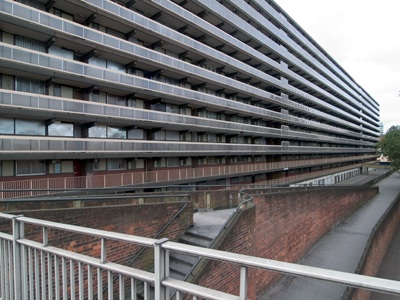‘in memory of the future’ 5 mins video loop, 2008, was made on the Hetgate Estate, a postwar housing estate in south London.
The Heygate and adjacent Aylesbury estates, built in the early 70’s are prime example of post war modernism. Built on bomb damaged wasteland, what was not destroyed by the Luftwaffe was cleared for the site of a dream, a post war dream of the future. Now the Heygate is coming down, after a life span of 50 years the aerial walkways, the communal heating system, the tower blocks and low rise garden flats are all coming down.
I have been walking through this estate for ten years, over the aerial walkways, to the tube from my house. It is the scenic route when I have time. I have enjoyed the multitude of contradictions it somehow brings to mind, between desires for utopia in its conception to the entropy that followed. When I built my own house nearby my building inspector was in charge of these buildings. He told me how the prefab units that where inset into the frames were bolted on with one bolt a side rather than the required four and that he wouldn’t live in the Heygate for safety reasons, quite apart from anything else. The flats are actually over size inside and very nice but the image of the place is ubiquitous in the media, cop shows adverts, etc whenever they need an urban distopian location. The extent to which the design, the upkeep, or the social mix is responsible for this is an interesting discussion, but the result can not be argued with. A friend who lived there made sure she was back in her flat by nightfall and did not venture out after that.
I have recorded myself wondering the walkways with binaural microphones (in ear microphones that give you an uncanny sensation of presence, in the place recorded, you can almost feel your body in space). At the same time I took photographs, intermittently of the vanishing point of the external balconies running the length of the building, the aerial walkways, the sheer sides of the rising tower blocks. Actually I ran round the estate, the rhythm of my breathing and footsteps an audible reminder of my body in the space, a background rhythm to the photos, which flash up and fade to black again before the next image, revealing for a moment the visual surrounding of the sound field being listened to, and by the light of the image the audience of a room otherwise dark with a video projection. In the intervening darkness I hope the viewer, denied the orientation of sight will returns to perceiving the environment through sound and a tactile awareness of their own bodies in the darkness of the projection room.
The running gives a sense of urgency, a chase scene, a rushed documentation as well as making explicit the body behind the camera in this utopian/distopian space. The images like flashes of memory or a brief vision of the future question the linearity of vision born during two world wars, and the desire to transcend this history for a new utopia. The breathing and running soundtrack foreground a sense of the body in space that somehow seems absent in the incorporeal vision of a modernist future.
After the Heygate has been demolished I anticipate these pieces working in a slightly different way, like flashes of memories, of the past or perhaps like ‘La Jette’, of the future, a confusion of the past, the future and desire, a desire for modernity.
This piece was recently screened in the adjacent ‘Elephant and Castle Shopping Centre’, rumoured to be the first shopping centre in Europe, which although unlikely, might be considered the first ‘Mall’ style shopping centre in Europe. This is a place that long since lost the sheen of the modern Mall for a chaotic mix of shops and cafes that form the centre for the local immigrant communities, most notably Columbian. A place that has the international feel of a remote departure lounge, and shares with the Heygate a once clear and precise vision long since integrated into the chaos of circumstance.


